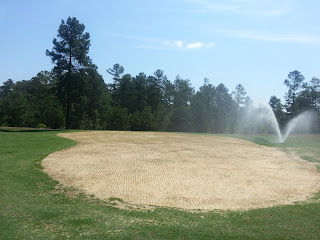The modern American golf course has an irrigation system composed of hundreds of sprinkler heads, computer controllers and pump stations capable of pushing millions of gallons of water to irrigate the golf course. The purpose of the irrigation system is to supplement natural rainfall in order to keep the turfgrass plant healthy. When the game of golf evolved in Scotland it was played on fescue in seaside settings on sandy well drained soils. As the game moved around the world it came to be played in different climates and different grass species were utilized. Nevertheless, the desired playing conditions did not change. The modern irrigation system became one of the tools used to create good golf course playing conditions. The restrained and judicious use of that modern irrigation system is necessary to create ideal playing conditions.
Living in the Sandhills of North Carolina, we are blessed with soils that are typically well drained. However, not everywhere is sandy. Under these rolling sandhills at various depths is a subsoil of clay. Where the sand and the clay intersect you will find groundwater emerging to create the many streams and wetlands on the Forest Creek site. We estimate that under normal conditions, approximately 500,00 gallons of water "springs" up on the Forest Creek site each day filling our lakes. Natural rainfall adds even more water to our lakes. The location of these groundwater springs changes seasonally based on the depth of the water table. In the summer, most of the springs on site will dry up. Many of the streams will stop running in the summer as the water table lowers. Heavy rains move quickly into our sandy soils causing the water table level to rise. We will then see the groundwater emerge in different places. The routing of the Forest Creek golf courses traverses sandy hills and crosses numerous wetlands. As the golf holes were shaped and the soil profile was changed, thousands of feet of drainage pipe were installed to move goundwater off of the golf courses. Thousands of additional feet of drainage has been installed in the years since construction. The goal was and still is firm and dry playing conditions.
There are presently wet areas on many areas in the fairways of the North golf course. When we see a wet area we ask ourselves if there is a problem with the irrigation system. We ask ourselves are we overwatering. We are also concerned with leaks in the irrigation system. The irrigation system is a grid of rubber gasketed pipe. The system is maintained at a pressure of 120 PSI so leaks do regularly occur. If we suspect that a wet area is caused by a leak , we will valve off the irrigation system to see whether the wet areas will recede. We also analyse the location of our internal drainage in reference to wet areas as this indicates where springs have occured in the past. We believe that most all of these wet areas on the North golf course presently presenting themselves in the fairways are groundwater. Our heavy spring and summer rains have raised the water table and caused seasonal springs to present themselves in the soil profile above the drainage system. We cannot control the rain. We try and control our use of the irrigation system. We cannot control the water table but we can try and manage it with drain lines.
Next week, we will begin extending our existing drainage systems into these problem wet fairway areas. We will prioritize the drainage projects based upon their severity. Most of these wet areas will dry up naturally as the water table recedes. However they will come back when we experience more heavy rainfall.
It is our goal to irrigate as little as possible to keep the turfgrass plant healthy. There are times when we will water more than we would prefer such as ryegrass establishment and transition. There will be times when we have programmed our irrigation system to water and we get unexpected rainfall causing us to contribute to wet conditions. There are times when the rainfall will be excessive and wet areas will occur. But we will always strive to achieve playing conditions that are firm and fast rather than lush and green.



















